FXOpen
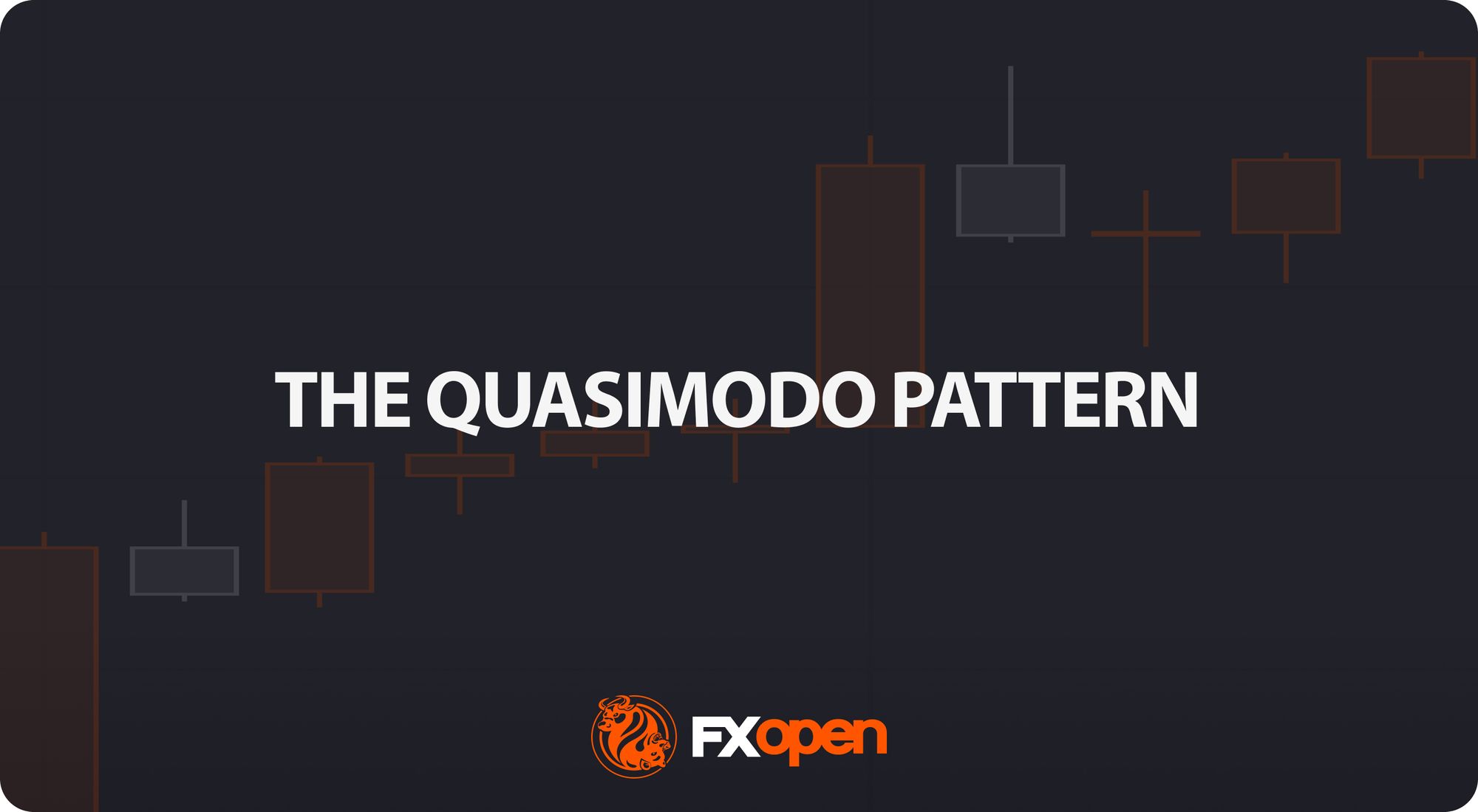
The Quasimodo (QM) pattern is a lesser-known formation that closely resembles the classic Head and Shoulders. While many traders overlook it—or even mistake it for its more popular counterpart—the Quasimodo offers valuable insights for spotting potential reversals. In this article, we explore the definition of the Quasimodo, its mechanics, and trading rules.
What Is Quasimodo (QM) in Forex?
The Quasimodo is a reversal chart pattern forming at the end of a solid trend. It can be spotted on any timeframe of any asset. It means you can find a Quasimodo on forex, stock, and commodity charts. This pattern can be bearish and bullish.
Bearish Quasimodo
A bearish QM occurs at the end of an uptrend and signals the formation of a new downtrend. It consists of three peaks (a head in the middle and two shoulders at the sides) and two troughs. The second peak (head) is the highest, and the second trough is the lowest.
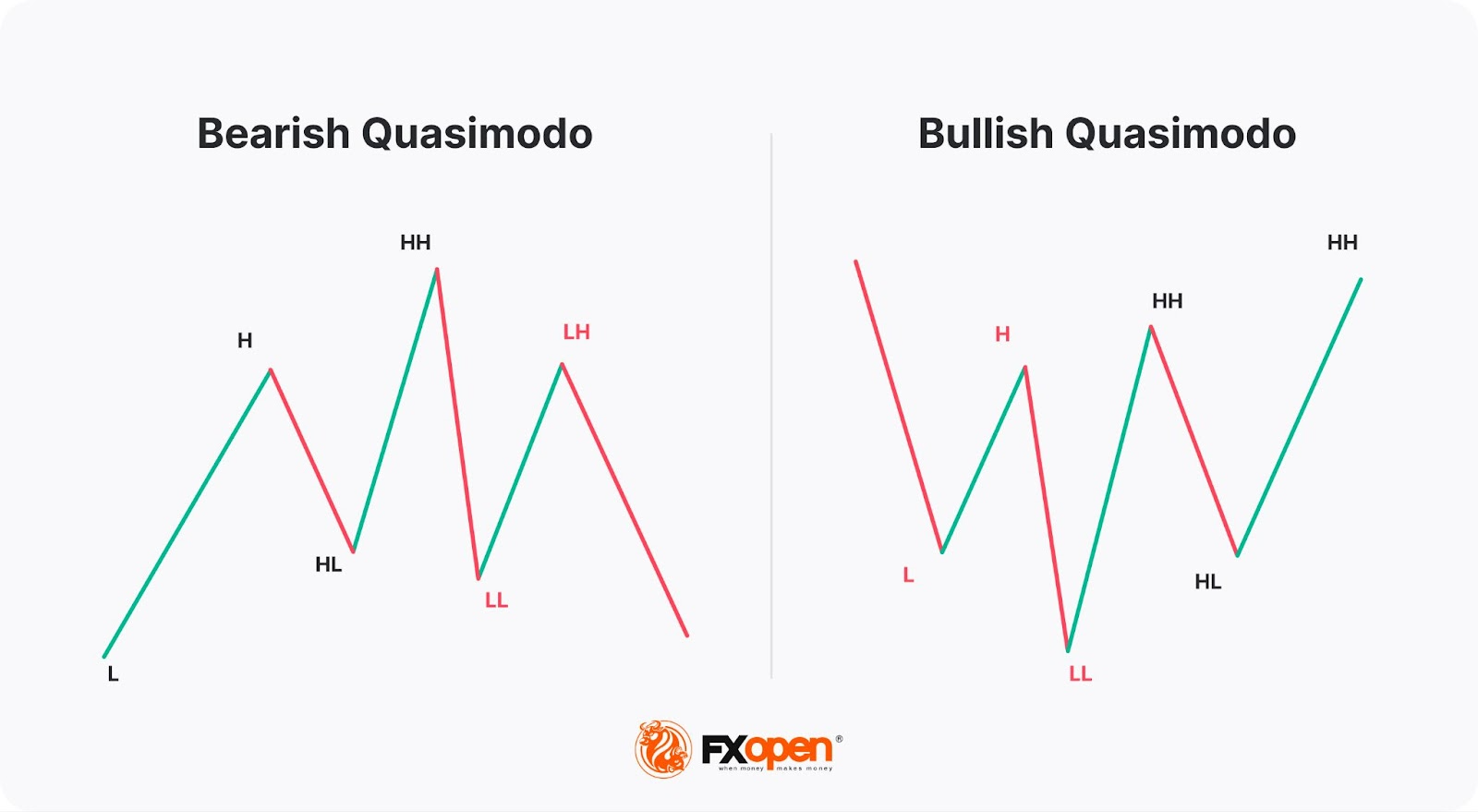
Bullish Quasimodo
A bullish (inverse) Quasimodo occurs at the end of a downtrend and signals a potential uptrend. It consists of three lows (a head in the middle and two shoulders at the sides) and two maximums, where the second trough (head) is the lowest and the second top is the highest.
Significance of the Quasimodo Pattern
The Quasimodo trading pattern holds psychological significance in trading because it represents a moment of exhaustion and potential reversal in market sentiment.
Traders often view the pattern as a signal that the prevailing trend's momentum is weakening, indicating a shift in market psychology. When traders spot a Quasimodo formation, the battle between buyers and sellers is a tipping point. The formation of the pattern suggests that market participants are hesitant to push prices beyond certain levels, leading to a reversal as the trend loses strength.
In terms of reliability, the Quasimodo pattern is considered a robust pattern for identifying trend reversals, particularly when supported by other technical indicators like the RSI or MACD. Unlike more common patterns such as the Head and Shoulders, the Quasimodo provides unique entry and exit points, making it a valuable tool for traders looking to capitalise on market reversals.
Its reliability might increase in strongly trending markets, where the previous trend is well-defined, and the pattern clearly indicates a reversal. While no pattern guarantees an effective trade, this distinct structure offers traders a compelling case for developing a Quasimodo pattern strategy.
The QM Forex Trading Strategy
A significant advantage of the QM reversal pattern is that it may help traders identify entry and exit points.
Sell Trade
The theory suggests that a trader opens a sell position as soon as the third peak is formed, at the same time the price should set a lower low (the second bottom). The second low could be used as a take-profit target. The head would serve as the stop-loss target.
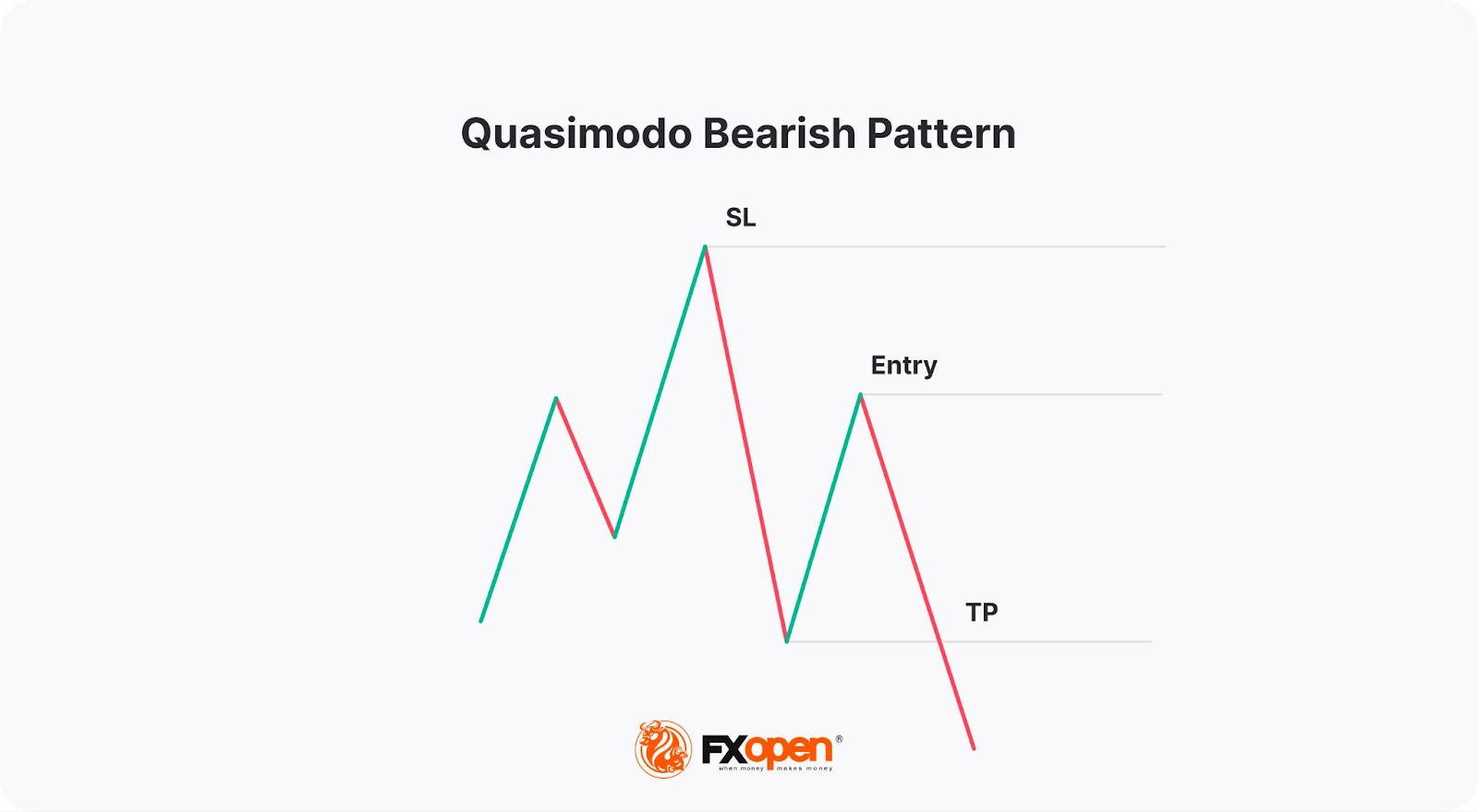
Buy Trade
According to the bullish Quasimodo pattern’s rules, a buy position could be opened as soon as the second shoulder appears. You may set a take-profit order at the peak between the head and the right shoulder and use the head as a stop-loss target.
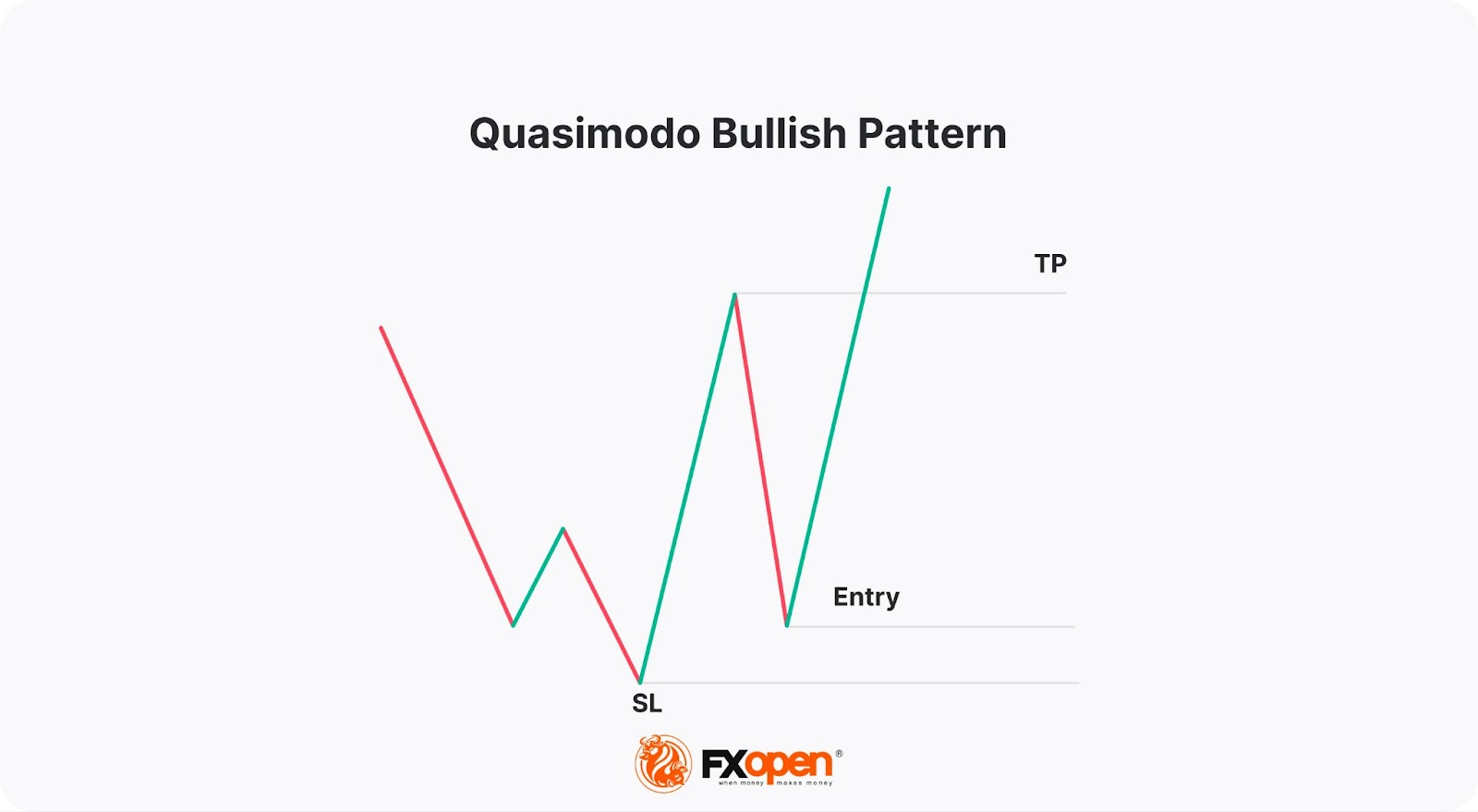
Non-Standard Formations
Any theory is always based on perfect conditions, but the actual market often differs. For example, on the chart below, the take-profit target (1) is three times smaller than the stop-loss level (2). In such cases, standard rules don't work.
In this particular case, we would either reduce the size of the stop-loss order or increase the take-profit target. Your decision will depend on the market conditions. For instance, you could increase the take-profit value if there are strong signals of a trend reversal from other reliable indicators. If trading volumes are low, the strategy suggests shortening the stop-loss distance.
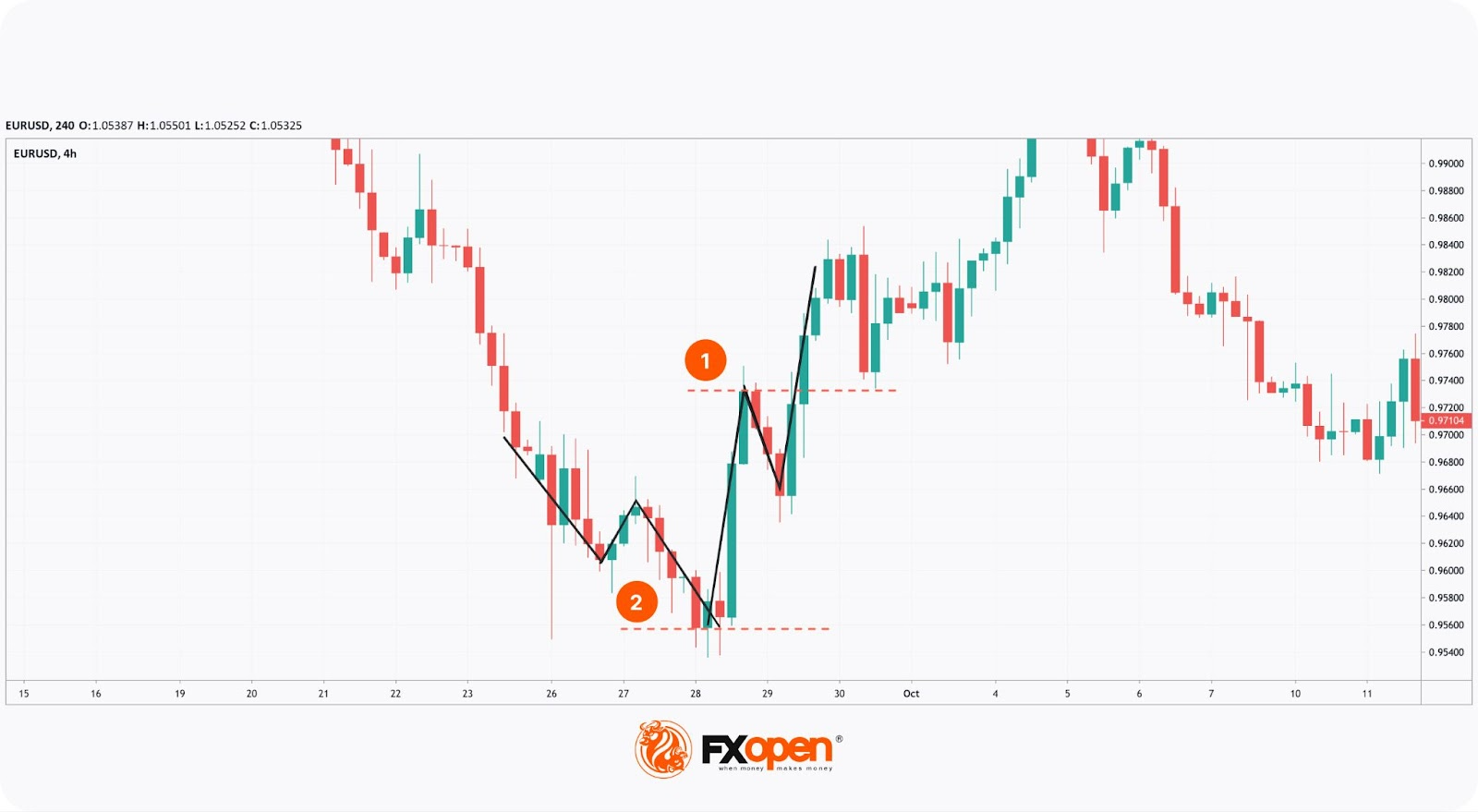
What Is the Difference Between Quasimodo and Head and Shoulders?
The QM and the Head and Shoulders are reversal patterns. They look similar but still differ and provide different entry/exit points. Take a look at the image below.
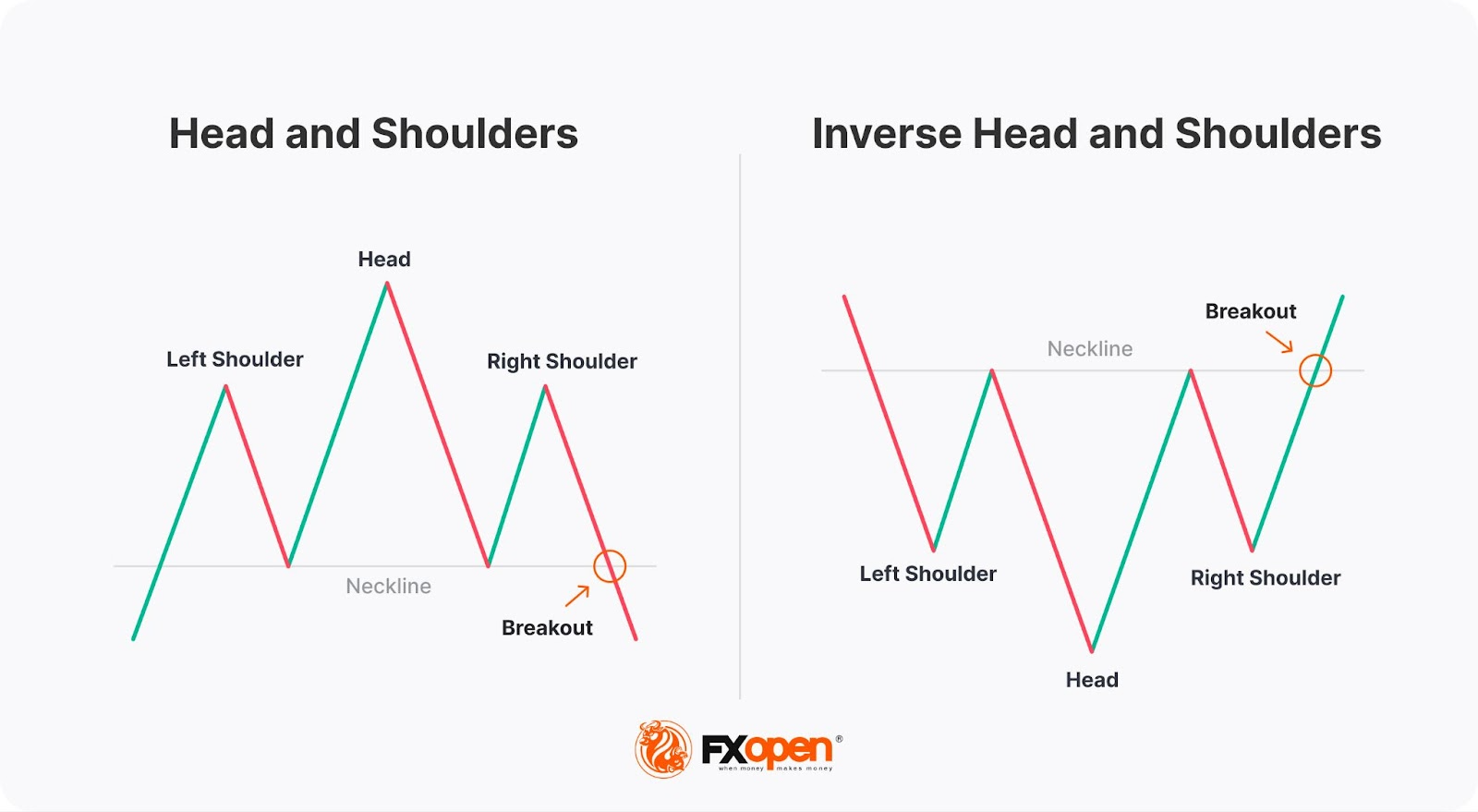
The bearish Head and Shoulders also has three maximums and two minimums, where the second peak (head) is the highest. However, the second trough is at the same level as the first one. This is the difference between the QM and the Head and Shoulders patterns.
The inverse Head and Shoulders consists of three lows and two peaks, where the second trough (head) is the lowest, and the second top is at the same level as the first.
To make it easier, draw a line, a so-called ‘neckline’, through the two troughs in a bearish formation and the two maximums in a bullish one. If the neckline is horizontal, it's the Head and Shoulders. If it's angled, it's the Quasimodo.
Why Distinguish Between Patterns?
Although the QM and the Head and Shoulders look similar, they have different trading rules.
- When trading the bearish QM pattern, you are supposed to go short on the right shoulder. In the Head and Shoulders, you would wait for the price to break below the neckline after the right shoulder.
- In the inverse QM, you could enter the trade at the third trough (right shoulder). But when trading on the inverse head-and-shoulders formation, the common rule is to enter the market not on the second shoulder but after the price breaks above the neckline.
The stop-loss and take-profit levels will differ, too.
In the bearish Head and Shoulders, the take-profit target equals the distance between the head and the neckline. The stop-loss level is usually placed slightly above the third top or in accordance with the risk/reward ratio.
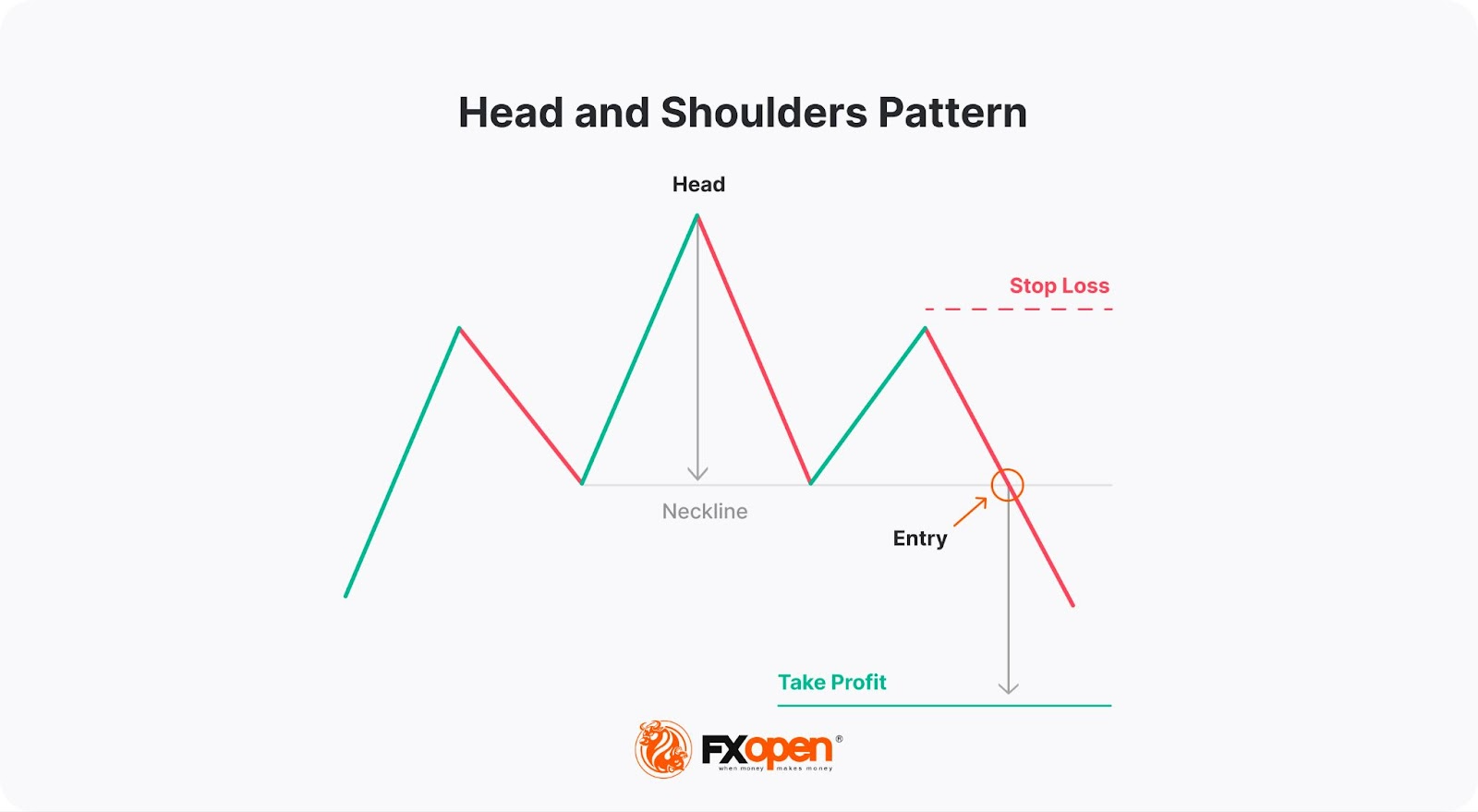
In an inverse Head and Shoulders formation, the profit target is the same as the distance between the head and the neckline. The stop-loss level is usually set slightly below the third bottom or corresponding with the risk/reward ratio.
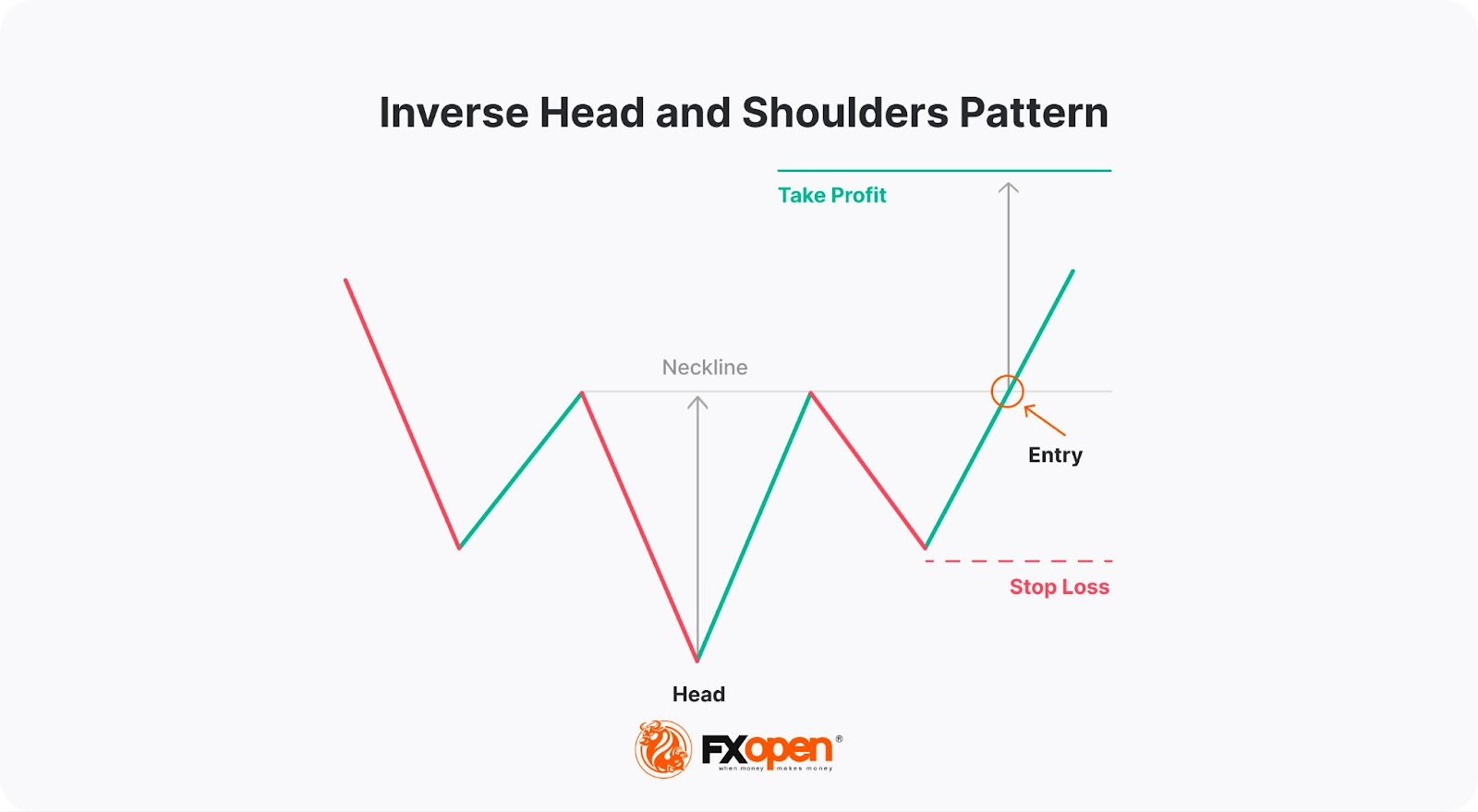
How Can Traders Confirm Quasimodo (QM) Signals?
Although patterns are reliable technical analysis tools, they must be validated. There are several methods to confirm the Quasimodo, meaning using various indicators and tools that appear ahead of a trend reversal.
The most popular indicators are the relative strength index (RSI), moving average convergence divergence (MACD), and simple moving average (SMA).
Divergence
RSI and MACD signal a trend reversal in several ways, but the divergence method is the most dependable.
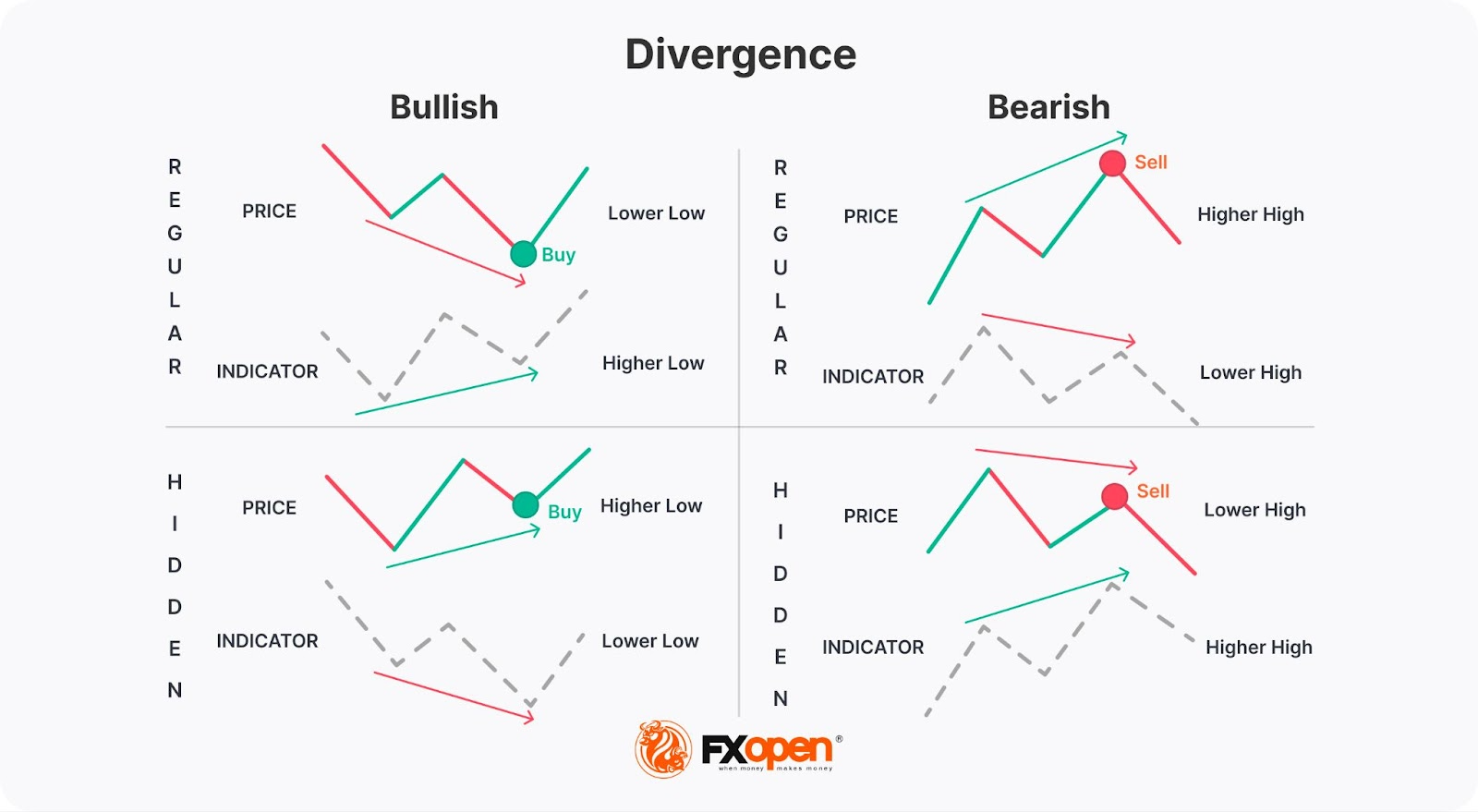
- Regular Bullish Divergence: When the price creates lower lows, but the indicator forms higher lows, it suggests the market might be poised for an upward turn.
- Regular Bearish Divergence: When the price reaches higher highs, but the indicator forms lower highs, it indicates a potential market decline.

The chart above shows a regular bullish divergence between the price chart and the RSI indicator. As the RSI formed a higher low and left the oversold area, you can anticipate a price reversal. Once the second shoulder of the Quasimodo appears, the market creates conditions for a buy trade.
Moving Averages
A simple moving average is widely used to confirm a trend reversal. You will need two MAs with different periods, depending on the timeframe you trade on. 50-, 100-, and 200-period MAs are typically used on high timeframes, while 9-, 12-, and 21-period MAs are more popular on shorter-term periods.

Look at the 4-hour chart of the EUR/USD pair. The price formed an inverse QM. When the second bottom appeared on the chart, a 9-hour MA crossed the 21-hour MA from bottom to top (1). It's a so-called golden cross that signals an upward movement. As the cross occurred before the price formed the third bottom of the QM, you could open a buy trade at the second shoulder with a strong confirmation.
If you want to practice spotting the QM pattern, you may consider using FXOpen’s TickTrader trading platform.
How Can You Trade the Quasimodo Pattern?
Trading seems simple until you enter the real market. So, always be ready for exceptions. These rules may support you in building a trading strategy with the Quasimodo pattern.
- Medium- and long-term timeframes are commonly used when trading with the Quasimodo setup. It takes time to identify the pattern. Therefore, using it on short-term timeframes may lead to missed trades.
- Identify a strong trend. The stronger the previous trend, the more reliable the signal is supposed to be.
- Recheck the stop-loss level. Although the rule offers a particular stop-loss distance, the QM may look different. Therefore, you could use the risk/reward ratio of 1:2, 1:3, or larger.
- Don’t confuse bearish and bullish formations. A QM is formed at the end of an uptrend, while an inverse QM appears when the downtrend ends.
- Don’t confuse the Quasimodo trading pattern with the Head and Shoulders.
Common Mistakes and Pitfalls
When trading the QM pattern, traders often fall into common mistakes:
- Ignoring confirmation signals: Failing to use additional indicators, momentum indicators, to confirm the pattern can lead to premature or losing trades.
- Overtrading: Trying to trade every Quasimodo pattern without considering the broader market context or trend strength can result in overtrading and losses.
- Neglecting market conditions: Not accounting for low volatility or trading during choppy market conditions can reduce the pattern's reliability.
- Misjudging pattern completeness: Entering trades before the Quasimodo pattern fully forms may result in false signals and unexpected reversals.
- Improper position sizing: Failing to adjust position sizes based on market conditions or pattern strength can lead to excessive risk.
Takeaway
The Quasimodo pattern is a powerful yet often overlooked chart formation that is used to spot potential reversals and plan precise entry and exit points. By understanding its structure, confirming signals, and applying proper risk management, traders may incorporate the Quasimodo into their strategies.
If you want to trade with Quasimodo or any other pattern in over 700 markets, consider opening an FXOpen account. Gain access to forex, stocks, commodities, and more and trade with low commissions and tight spreads.
FAQ
What Does Quasimodo Mean in Trading?
In trading, the Quasimodo definition refers to a reversal pattern that signals a potential change in the trend direction. It indicates a shift from an uptrend to a downtrend (bearish Quasimodo) or a downtrend to an uptrend (bullish Quasimodo). Traders use it to identify entry and exit points.
What Is the Quasimodo Structure?
The Quasimodo consists of three peaks and two troughs in the bearish pattern and three troughs and two peaks in the bullish pattern. The middle peak or trough (head) is the most prominent, flanked by two smaller shoulders.
How May Traders Use the Quasimodo Pattern?
Traders use the Quasimodo pattern to enter trades at potential reversal points. Typically, they look to sell near the right shoulder in a bearish QM or buy near the right shoulder in a bullish QM. The invalidation level is usually set just beyond the last swing high or low, while profit targets are placed at previous support or resistance levels.
What Is the Quasimodo Pattern in Crypto*?
The QM meaning in crypto* is the same as in other markets. The Quasimodo signals potential trend reversals in digital assets. The reliability of its signals often depends on market conditions and is typically confirmed with indicators like oscillators or those that reflect trends.
*Important: At FXOpen UK, Cryptocurrency trading via CFDs is only available to our Professional clients. They are not available for trading by Retail clients. To find out more information about how this may affect you, please get in touch with our team.
This article represents the opinion of the Companies operating under the FXOpen brand only. It is not to be construed as an offer, solicitation, or recommendation with respect to products and services provided by the Companies operating under the FXOpen brand, nor is it to be considered financial advice.
Stay ahead of the market!
Subscribe now to our mailing list and receive the latest market news and insights delivered directly to your inbox.








